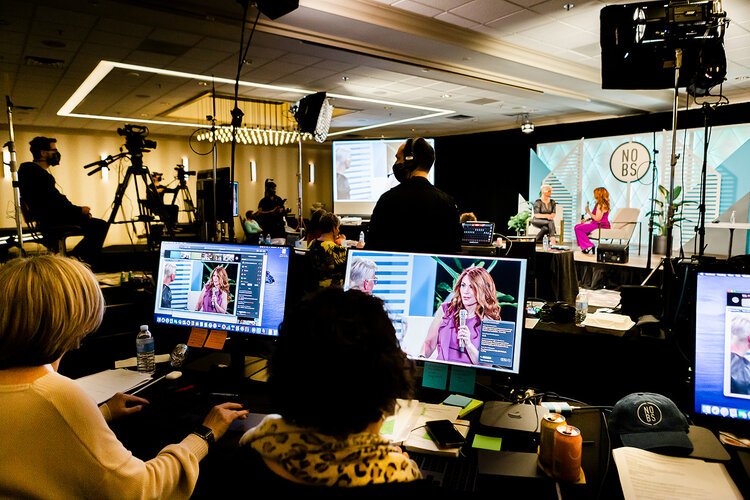Level-up Your Virtual Events: Functionality, Enhancements & Budgets
“For virtual events, the Memo team is the bridge between people and technology.”
Let’s start from the beginning.
Just like every event or marketing campaign, let's start with the purpose. Events - both live and virtual - are vehicles and channels for marketing messaging and campaigns. Just like any of our marketing projects, we begin with Discovery. Questions to tackle include:
What is the purpose of the event?
What is the core messaging and target takeaways?
What additional content is or could be available?
What functionality is needed?
Who is your audience?
How big is your audience?
Where is your audience? Hybrid and/or remote? National and/or international? Different timezones?
Who and what will be featured in the program?
Who are the potential partners?
What is the ballpark budget?
These answers (or often lack thereof of, which is totally ok) will serve as the foundation for Conceptualization. All of these factors help define the framework of what the front-end and back-end of the virtual event looks like.
What, Who, Where, How?
Let's start with Question #8. Who and what will be featured in the program? Who are the speakers and from where will they speak?
If we're able to broadcast from a centralized location, then we have more control over what we're pushing out onto the stream. We can create a set and bring in a robust production package to enhance the production quality of the audio, video, and lighting. With this approach, we have the most control over the production value.
Alternatively, speakers may be remote. We'll pull their camera and audio feeds into a centralized production hub, then push out the program to attendees. With this route, we're depending on the video, audience, lighting, and bandwidth quality that they're giving to us in the production hub. We have less control over the production value, but provide high-touch insight to make the most of what they have. We could also ship a production kit to them to enhance what they have, but there are still limiting factors.
With the latter route, we manage risks and maximize quality control by layering Zoom rooms. We hold upcoming speakers in Green Rooms and a Speaker Ready Room to check footage and push them out to broadcast seamlessly.
Our go-to is Zoom, here’s why.
With virtual events, there are more variables outside of our control. We're depending on the audience's ability to navigate and optimize technology so they can take in a show in the way we're intending. Group and one-on-one coaching and on-demand support through chat is helpful, but not everyone who needs it takes advantage of those resources.
We're partial to Zoom. Speakers and audience members are more familiar and comfortable with the platform. The reliability and functionality suits most needs as well. During a show, we often toggle between Zoom Webinar for broadcasting and Zoom Enterprise for more dynamic and interactive programming. Keep in mind that Zoom will decrease the resolution to protect their capacity and the audiences' experience will also depend on their internet and external circumstances. There are challenges for every platform, but we find that the benefits of Zoom outweigh the downfalls.
The greater the functionality, the more robust the production plan needs to be.
What's not covered by Zoom? Communication channels for invitations and such, registration, and more robust interactions among attendees and between attendees and speakers. Mulitple platforms serving different needs can be integrated to result in the best user experience. We're excited about the emergence of newer platforms, such as Attendify. To be honest, we aren't fans of Cvent. The back-end is clunky and the customer support leaves something to be desired.
Most of our clients are concerned about Zoom Fatigue and engagement - AS THEY SHOULD BE! The good news is that virtual events can be fast paced, energizing, and captivating. We'll dive into orchestration and enhancements shortly, but on the platform front, switching between live speakers, pre-recorded content, and breakout discussions keeps the program moving and maintains attention. When sessions or days are too long, attendees settle in and zone out. Keep it fresh, moving, and fun!
Identify and seek out blindspots. Ask questions. Being aware of your ideal and actual functionality helps flesh out the best production plan. A small change or misunderstanding may have big ripple effects. Never assume!
Part of producing events is managing what some see as chaos.
What's not covered by Zoom? Communication channels for invitations and such, registration, and more robust interactions among attendees and between attendees and speakers. Multiple platforms serving different needs can be integrated to result in the best user experience. We're excited about the emergence of newer platforms, such as Attendify. To be honest, we aren't fans of Cvent. The back-end is clunky and the customer support leaves something to be desired.
Most of our clients are concerned about Zoom Fatigue and engagement - AS THEY SHOULD BE! The good news is that virtual events can be fast paced, energizing, and captivating. We'll dive into orchestration and enhancements shortly, but on the platform front, switching between live speakers, pre-recorded content, and breakout discussions keeps the program moving and maintains attention. When sessions or days are too long, attendees settle in and often zone out. Keep it fresh, moving, and fun!
The good news is that you don't have to be in it alone and there are people like us who are working in this space on the daily. Together, let's seek out and identify blindspots to flesh out the vision and align expectations. A small change or misunderstanding may have big ripple effects. Never assume or bank on variables working themselves out!
Now that the framework is in place, the leveling-up begins.
Many of our clients begin with "I don't want my virtual event to just be another Zoom call." MUSIC TO OUR EARS! The best way we can create a special virtual experience is through strategic, rehearsed orchestration and flow. We even script out some of the seemingly spontaneous interactions to ensure they come off as natural and organic. As much as we love design boards and visuals, a beautiful, detailed Run of Show is possibly more stunning to us.
The keys to intentional orchestration and flow are a cohesive vision, speakers who are engaged and open to putting in the work, and an executive producer leading the production team through air-tight execution.
The Run of Show should cut between an emcee guiding the audience throughout the virtual show, quick keynotes, panels, curated conversation between speakers, breakouts, audience member shares, ice breakers, activities, worksheets, and more.
But be sure to circle back to Questions 1-5 to ensure the overarching messaging and flow are intentional and align with the purpose and goals.
Keep it fresh and fun with enhancements.
To maintain the audience's attention and create memorable moment, let's add some additional layers to the show. Light hearted elements like music add fun energy. We would never host a silent in-person event, so why not bring the same element to virtual? Looping in other entertainers bring fresh energy, serve as conversation starters, and bond the group as well.
Through fulfillment, we curate and coordinate swag and special items to be shipped in advance of the show. From swag and props to custom workbooks and packaging, fulfillment makes the abstract virtual event feel tangible and hands-on.
Ground rules can also help. By setting expectations in advance, you can give the audience permission to have fun and actively contribute to the experience and energy. Ask them to keep their cameras on, dress down or up, get up and dance, grab a coffee or cocktail anytime.
Just like any other elements, make sure your enhancements and communications are intentional and purposeful, tying back to a cohesive strategy, theme, and event identity.
Virtual event elements are scaleable to suit your budget.
Many event hosts experience some sticker shock when they see how the virtual costs creep up with functionality, production value, and audience size.
Virtual events are often marginally more cost-effective than in-person AND they reduce barriers to reach larger audiences, which drives up volume and enhances sponsor value. Most of the event elements we've covered in this memo are scalable, but the more cost-effective route requires creativity, the right partnerships, and a greater tolerance for potential missteps and deviances from the plan.
Since COVID-19, our virtual event budgets have ranged from about $75,000-$400,000 including fulfillment which ranges from about $75-$150 per recipient. The greatest influencing factors for the budget buckets are how intricate the functionality is paired with the number of attendees that drives up Zoom rooms and (wo)man power to manage them.
Again, be sure to circle back to your purpose and prioritize your budget allocation accordingly.
It takes a village.
Virtual events are abstract. It's hard to envision what the end result will look like and it's nearly impossible to picture the back-end or what in the world is happening "in the cloud." This type of environment can be intimidating, but we serve as a bridge between people and technology to make the process and day-of-show more accessible and easier to navigate.
Our team serves as the project managers, producers, and stage members will our partners oversee the technical production, create scenic pieces, and add layers of entertainment. Additionally, we engage the local health department to ensure we're back healthy and safe as well as an on-site nurse to take temperatures, monitor in-room crew members, speakers, and attendees, and make sure we're sanitizing and hydrating. We also engage venues to house our product hub or stage set as well as caterers to keep us well fed and caffeinated.
While it's a different experience to produce events from a closed room, the energy we're still experiencing is incredible and exciting. While 2020 has been a wild ride, we're excited about the unlocked potential of virtual events.

